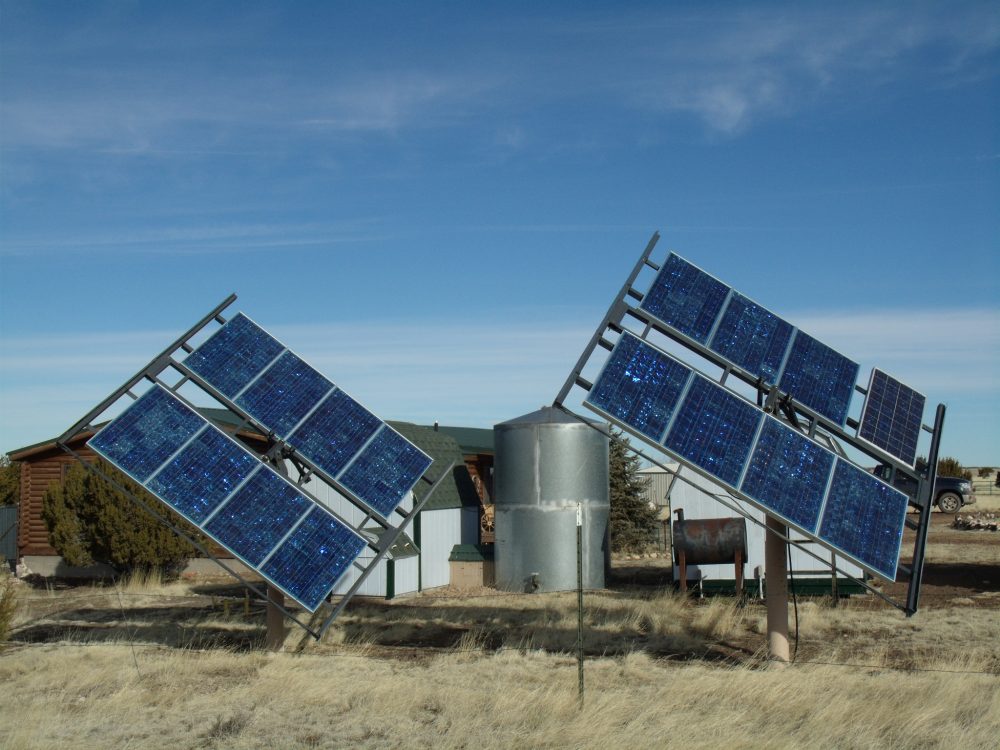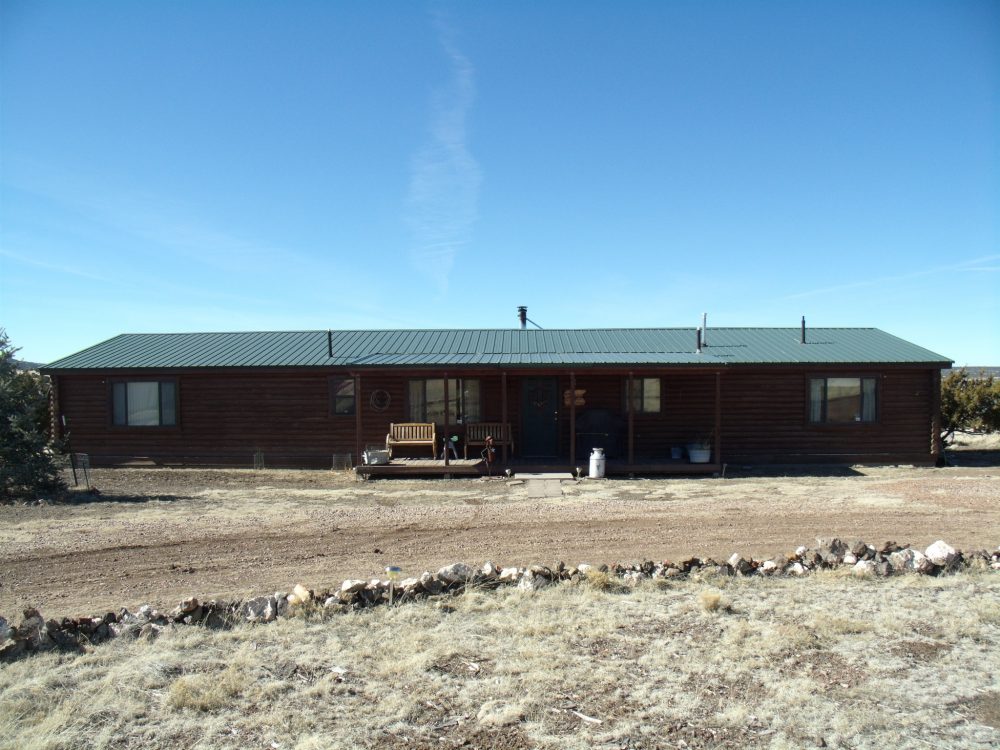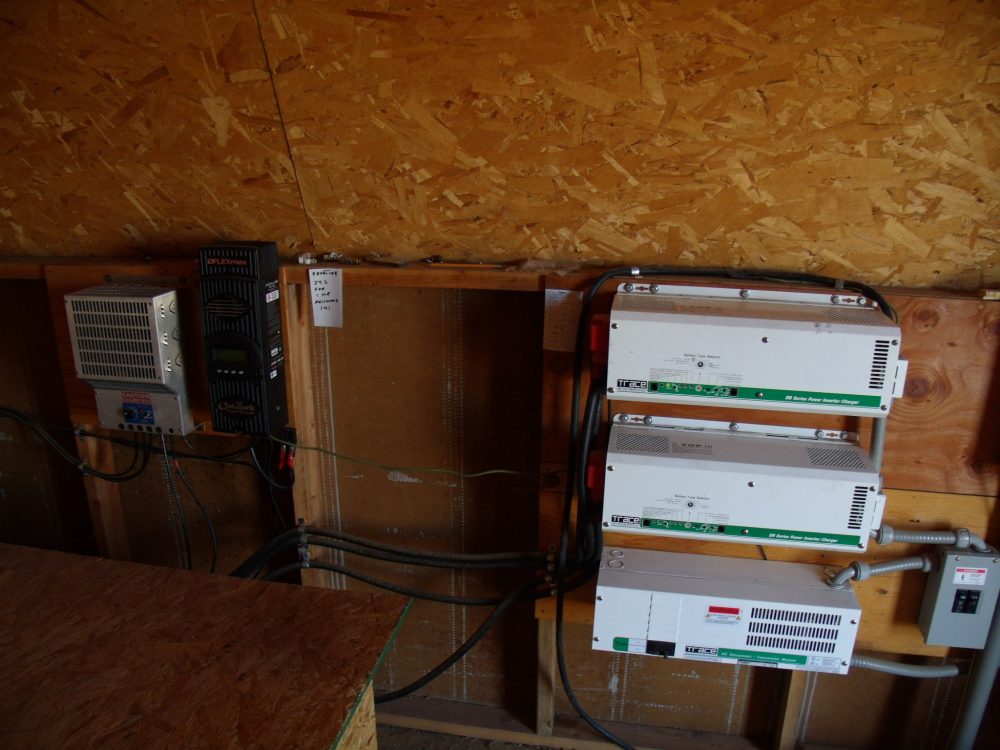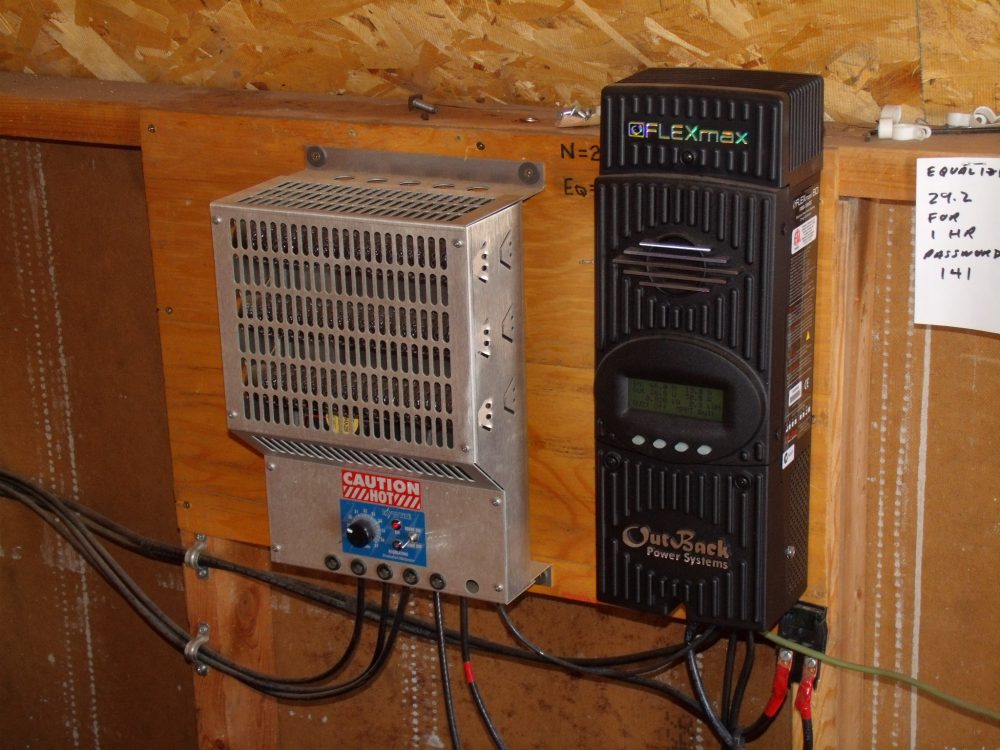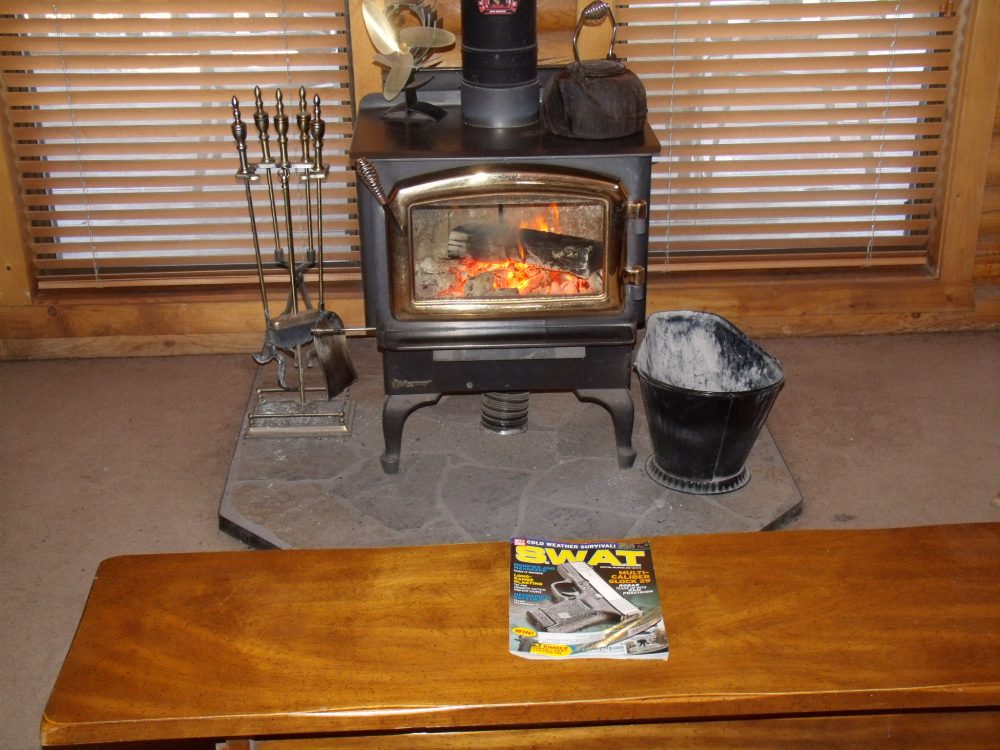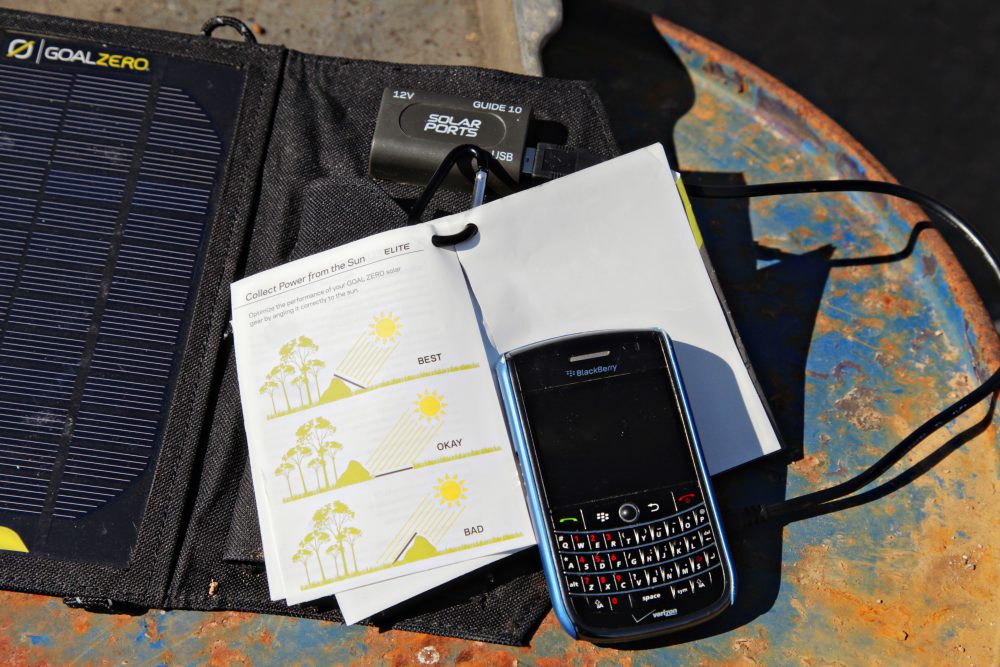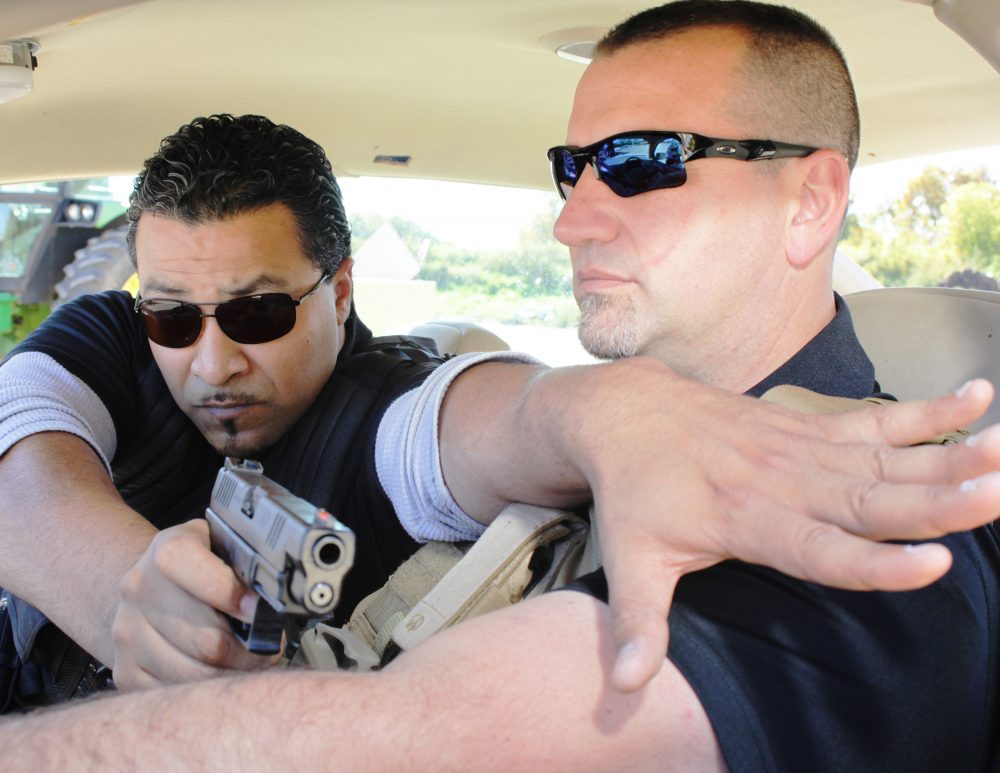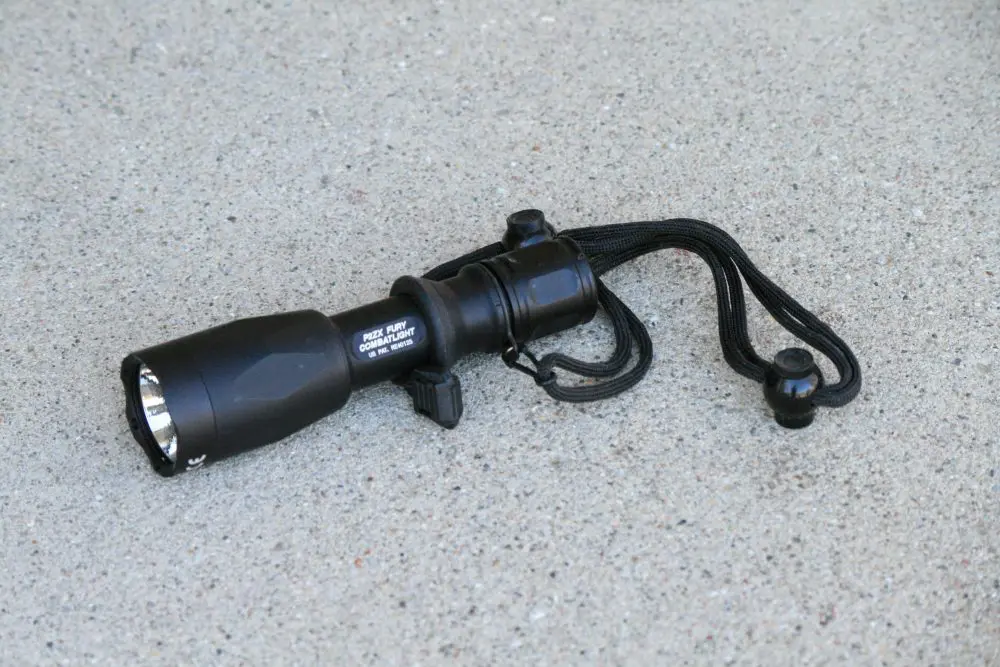“Occupy Movement To Turn Violent”
“Mexican Cartels Crossing The Border”
“Violent Weather Predicted”
“Infrastructure Crumbling, More Brownouts Ahead”
“Power Goes Out For Three Days County-Wide”
Take your pick—there are lots of reasons to be prepared. You have your gear: guns, ammo, food, first aid, medications, and hard-wear clothing. Your bug-out bag is packed and ready. Now, where will you go?
Many folks decide to look for (or create) a place off the grid, meaning off the power system and not connected to public utilities. Call it a vacation home, hidden ranchito, or get-away-from it-all spot—it’s the family rendezvous for a real breakdown of society. Some folks have an idealized view that in their safe haven, it will be all rainbows and butterflies until the crisis is past. Time for a reality check—no, it will not.
But living off the grid not only works but can be quite comfortable.
Solar panels on their trackers, following the sun. Water tank is visible in the background.
Table of Contents
FULL-TIME OFF THE GRID
For over a decade, my wife and I have been living full-time off the grid, making our own electricity, pumping water from our well, and flushing into a septic system. Once a year we buy a delivery of propane, but other than that, we have no utility connections. Since we are full time, ours is a 2,200-square-foot home—about three times what we would build for an escape plan.
How has it worked for us? Great!
We did not choose this as “preppers” or to “go green.” We liked the idea of no neighbors (our nearest neighbor is ¼ mile away and the next closest two miles). We wanted to keep our horses close and ride from home. I wanted to shoot without being forced to load everything in the truck, drive half an hour, and pay to take part in a regimented kind of shooting. We went off the power grid because it was cheaper than bringing wires in over two miles and then paying end of the line charges ($300 per month, regardless of how much power you use, until someone moves in beyond you!).
What is involved in creating a hideaway?
LOCATION
If you’re thinking about getting your own off-the-grid hideaway, you first need to consider location. We had a few ground rules:
I wanted shopping and entertainment not more than one hour from the house.
I like the seasons, so we went for altitude. We live at over 6,000 feet, which means we get some snow in the winter and have 90 degree days in the summer.
There are two major backcountry hazards you must consider—fire and flood.
Fire and Flood
Our area has seen two major wildfires since we moved here, neither one very close to us. I was a volunteer firefighter for six years and worked on major fires. You have no idea how sad it is to watch someone’s home turn to ashes simply because they had underbrush close to the house or wooden lawn furniture stored under their deck. There are lots of things you can do to protect what you have—look up “Firewise” on the internet and follow all the steps.
Flooding is much easier to counter. Every county has a flood-plain map that you should consult before you buy or build. One fellow did not, and when the summer rains came, he had six inches of water standing in his house for weeks—it was a total loss.
We prefer land with a slope for better drainage. During some strong storms, I have seen sheets of water an inch deep running down the slope past our house.
Much more than an emergency hideaway, this is where the author and his wife live full-time off the grid.
Accessibility
I would not look closer than two hours by car from any major city. Closer than that and those who did not plan ahead will be demanding you “share with them” when disaster strikes. Two hours is far enough away from most cities to keep the unprepared away. We are two miles from the blacktop—not a problem as we already had 4WD vehicles. You must strike a middle ground: accessible in bad weather, but not lots of traffic by the front door. Since we are literally at the end of the road, we don’t get casual visitors.
Food Sources
You also need to consider food sources. Unless you’re already a farmer, you’re not likely to grow your own food. How many supermarkets are in the area, for how big a population? And where are alternative sources? During one fire, the major city (population about 10,000) in our area was evacuated, but we knew where other markets were.
You need to build storage space for food—lots of it, and the kinds you already like. Supermarkets do not have big back rooms. Usually all their food is on the shelves. When transportation problems, storms, riots, or fuel shortages occur, what is on the shelf is about all they have.
Buying 100 pounds of rice is not a good deal if you don’t eat much rice now. And you must store it in such a way that rodents will not be able to ruin it. If you’re thinking of buying in bulk, buy a small quantity and try it first—you don‘t want to end up with a lot of food you don’t want to eat!
Neighbors
In picking a location, keep in mind that not everyone living in the backcountry are nice people. Burglary is a constant problem in some areas. If your cabin is truly hidden, it may be broken into and stripped. Our home, on the other hand, blends in with the surroundings and is hard to see from the road unless you know where to look. Choose an exterior that blends rather than contrasts with the area.
Also consider your neighbors. Do you really want a place next to the folks with four broken-down trucks in their yard? In real estate, this is called Neighbor Roulette, and you can win or lose, so a bit of research is in order.
Find a spot, then drive by it during the day and night on weekdays and weekends. The abandoned place down the road may be the local dopers’ weekend and evening hangout. Funny chemical smells from the place down the road? Could be a meth lab—look someplace else. How about the guys who host a rock band every Friday night with the volume turned up to 10?
Wind generator controller (silver), solar controller (black), and inverter (top box). From there on, it is all common household wiring.
SECURITY
Once you select your spot, you must start thinking about security, both hard (as in hardening the target) and soft (as in concealing your intentions). It does no good to wear your gun club shirt while meeting with your realtor or dealing with the county government. Most folks in the backcountry own and shoot guns, but there’s no reason to give the game away at the start.
The other side of living in the country is that everyone knows everyone else, so the nice guy at the County Recorder may mention to his pals that you are a shooter, and soon lots of folks who don’t need to know may think there are guns in your place.
This is a good time to take all gun-related stickers off your vehicles. The construction crew, electricians, and anyone else working on your cabin don’t need to know you’re a shooter either. They may be the salt of the earth, or they may be the rotten eggs.
Stashing
If you do plan to stash some guns and gear, they need to be secured out of sight in a safe. One friend had a small closet added to a room. After the builders left, he brought in a safe sized to fit into the closet. Thus the safe door was concealed by a typical closet door, and casual visitors would never know what was there.
You may also consider buying a 20- or 40-foot storage container. Some folks even bury them which, depending upon the soil, can bring on its own problems such as rust and water leakage. They are, however, much harder to break into than a wood or aluminum shed.
You can also add shutters to your windows. If you are not home, a heavy shutter can keep a casual thief where he belongs—on the outside! They can be nice looking (to satisfy your significant other) or completely removable for when you are living there.
Wind generator controller and solar controller, showing the battery state.
Alarm System
The final line of defense is an alarm system. We have one that works on a special cell phone connection and is monitored in the city. If there is a break-in or fire, the alarm company is instructed to call the Sheriff’s Office or fire department before they call us. We have some like-minded friends who have keys and the alarm code to our house. They live just a few miles from our place and have agreed to respond if the alarm company calls. We also have alarm company signs and decals on all approaches to our home. You don’t want to escape the city only to find your cabin has been stripped.
While you’re in town, get a P.O. box for all correspondence or have it sent to your city address. There is no home delivery where we live, and in truth I don’t want the mail piling up in an outside box—one of the easiest “tells” that you are not home.
POWER
The two biggest considerations once you have a spot are power and water. Power from the grid is great—as long as it works. In our area, the grid is notoriously unreliable. There are surges, brownouts, spikes and total failures. If a drunk knocks down a power pole around here, it’s three-plus hours before it can get repaired—in good weather. It can be two to three times that in a storm.
On the other hand, there’s a learning curve to living on solar/wind power. For example, the largest user of power in your home is your refrigerator. Newer ones are far more efficient, so don’t take your old one to your cabin. Buy a new one, which can also be much smaller.
When providing your own power, you learn what I call “time displacement”—high-load projects are done during the day, not at night. Being full-time residents, we have a dishwasher, but we don’t do the dishes after dinner. We do them during the day, when the sun is out. The same with washing clothes or anything else that takes a lot of power.
Warm fire and some good reading. Living is good off the grid, even in mid-winter!
Solar Power
A solar panel system has at least five components that must all work together. A decade ago, a solar panel produced 80 watts on a sunny day. Today, you can buy a single panel that will produce 375 watts! The panels go into a frame called a tracker, which follows the sun across the sky. The DC power goes through a controller and into a bank of batteries, so you have power after dark. As you use the power, it goes through an inverter, which converts it from 12v DC into 110v AC, so you can run all your usual lights and appliances. From the output side of the inverter, it is all common household wiring.
Wind Power
The one power source that produces at night or during overcast or snowy weather is a wind generator. Depending on your location, you can get quite a bit of power when the wind blows. Our location has the reverse problem—too much wind. Due to the terrain, 60mph winds for two to three days straight, all day and night, are not uncommon, and we have to turn our wind generator off.
Before we figured this out, we set fire to two wind generators that were too small for our winds! The wind generator has a separate controller to regulate the amount of power going into your batteries.
You would think that two independent power sources are enough—nope! Long (three to four days) periods of overcast skies with no wind mean no power. You still need a gas, diesel or propane generator. We opted for gas, as there are more sources for gasoline than the other fuels.
All of this is expensive, but in turn, we never get a power bill or worry about outages, and could not care less about rate increases. We do pay a lot more attention to the weather (how much sun and how much wind). The only care the system takes is checking the batteries every two weeks to insure they have enough water in them.
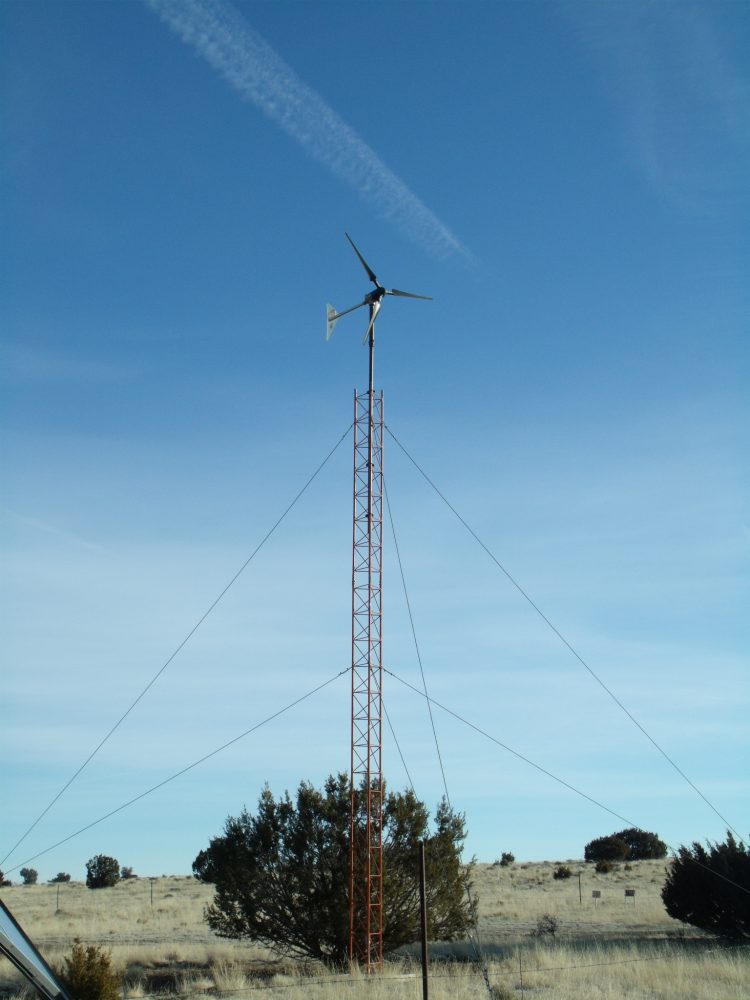
WATER
Unless you have reliable year-round surface water available, you need a well. They are expensive to drill and require two pumps—one to bring the water to the surface, the other to pressurize it for use in your house. Well pumps—the pump in the bottom of the well—are pricey to repair or replace, so we opted to store our water in an above-ground tank. This way, we control when we run the pump (sunny or windy days only) to control our power usage. Generally, the water systems run smoothly, but make sure yours is insulated and heated if, like us, you get sub-zero temperatures. When it’s minus 20 degrees, hauling water to flush toilets is no fun!
Hauling water is always a problem. It is heavy in any quantity, may not be available in bad weather or social interruption, the source is under someone else’s control, and how do they obtain it, as no power equals no water from their well. Plus, you will be burning fuel for your truck when you go to get it—fuel that you may not be able to replace (no power equals no gas pumps working), and you need to be sure it is safe to drink.
For heating your water, you may choose to skip the traditional water heater and install a point of use or constant supply system. At my house, there is no tank, and water is heated as we need it. As long as we have water and propane, we have hot water.
Once you have water coming into your cabin, where is it going to go? You usually install a septic system to dispose of the waste. Living on a slope let us put our septic system downhill from our well, for obvious reasons. If your property will not “perk” (allow wastewater to percolate down through the soil), there are alternative systems that can be used.
HEAT
Our home has a propane heating system—and we hate it! It ran on and off all the time and used large amounts of both propane and electricity (you pay a lot of attention when you make your own).
We installed a wood-burning stove. I recommend against a pellet stove (you have to buy pellets and the stove uses electricity) or a gas stove (uses lots of propane). I have been lucky to find wood for free. I cut it with my chain saw and let it dry for use. Our stove heats our home quite nicely. Plus if we should need to, we can cook on the top of the stove—something you cannot do with a pellet stove.
COMMS
Communication is by cell phone, also subject to power outages at the tower, although there is short-term battery backup. We do have internet access via satellite, so we are not completely isolated. We also invested in a couple of field telephones and set up a landline to our nearest neighbors for mutual assistance.
EMERGENCIES
Living remote means you’re on your own in a lot of ways. In fact our county website specifically states fire, law enforcement, and medical response will be delayed. When I was on the local fire department, it usually took at least six minutes for the first truck to leave the station. We covered an area of 1,000 square miles, so a 30-minute drive to the fire was not uncommon. And sometimes we did not have enough people to respond at all!
A house fire doubles in size every minute, so prevention, training and equipment are musts.
The same three elements are essential for medical emergencies—not just paper cuts and scrapes, but broken bones, deep cuts, and gunshot wounds that you may have to treat yourselves. Buying a gun does not make you a marksman, and buying a first aid kit does not prepare you to help in a medical emergency. Oh-dark-thirty in a rainstorm, with your family member screaming as they’re bleeding out, is no time to try reading the tiny instruction card in your first aid kit!
In my region, Sheriff’s Department and medical aid come from the county seat, about 25 miles away, but there are no deputies on duty after 2200 hours. Our average response time for a deputy is 45 minutes, sometimes longer. We expect to deal with any problems for at least an hour, in good weather. Since my wife and I are both former law enforcement officers, this is not a problem.
But what will you do with someone you need to detain for over an hour until the Deputy arrives? Planning is a big factor in backcountry living. In a major disaster, fire, medical, and Sheriff’s officers will most likely not be available at all.
CAN YOU DO IT?
How has living off the grid worked out for us? We love it!
It gets so quiet at times that I have heard the flap of a Bald Eagle’s wings as he flew overhead. We had 26 antelope winter on our place, and seven bull elk walked across a corner of our land. We have all the power we want, when we want it; in fact our house is “transparent.” If you don’t see the solar panels and wind generator, you wouldn’t know we are off the grid.
We have all the water we want and are warm in the winter. It’s a great way of life, as well as a way to stay safe if the world turns violent. Plus, prices now for land or existing properties are low. Once the economy gets back on an even keel, we can expect the migration of people from the cities to the countryside to resume, and prices will rise once again.
Anyone can live rough in a tent for awhile. But why would you choose to? Even the SAS say they can live rough, and will if the mission calls for it, but in the rear areas, they like to live well.
So can you, even off the grid!
Seth Nadel retired after serving 27 years as a Senior Special Agent with U.S. Customs. He was a firearms instructor for 25 years, including nine years as the lead firearms instructor at the Tucson Customs Academy.
